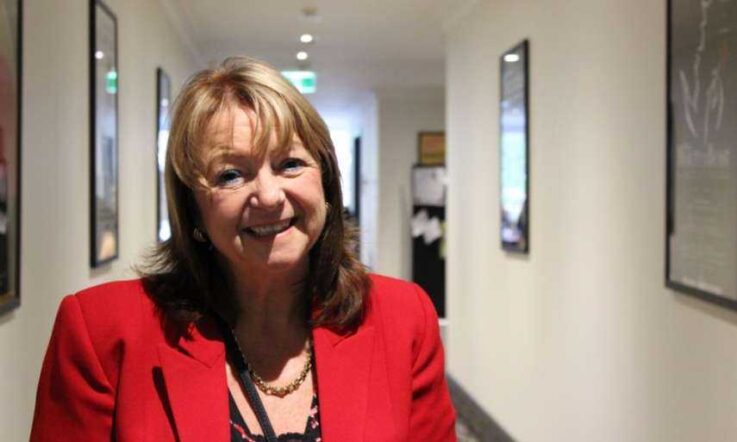In his article published earlier this year, Robert Marshall discussed the challenges of leading sustainable school improvement. He noted that: ‘Having a commitment and desire to improve student outcomes is one thing, but putting together an explicit plan and communicating that to staff and the school community is the difficult part'.
In this Q&A, Teacher editor Jo Earp chats to Beth Gilligan, Principal of Dominic College in Tasmania, about her approach to leading and communicating a school improvement agenda. The K-10 co-ed Catholic college in Glenorchy invited Professor Geoff Masters to give a presentation to staff on the topic of school improvement in 2013.
The following year, it invited a team from the Australian Council for Educational Research (ACER) to carry out a review of practice against the nine domains of the National School Improvement Tool (NSIT). From there, it developed an explicit school improvement agenda focused on three priorities: student data discussion and analysis; literacy and numeracy; and, a quality teacher development program.
Going back to the initial planning, how did you go about setting the timelines – the short- and long-term goals – was that a group decision or something the principal has to take the lead on?
I think that's a group decision. Bringing [in those] timelines was certainly what the ACER review team really pushed on. We've tended to timeline things over a two-year period … and, for example, in our targets with pedagogy and literacy (and specifically writing) we dovetailed those together. We actually didn't anticipate that we'd do that [initially]. Sometimes along the school improvement pathway you'll find there are moments where inspiration comes from people to say ‘we should be aligning these two improvement targets together'. But also sometimes you'll find, as we all do, as we start to look at how we will improve in an area we get better at looking what we need to do. Once you start reading about it, unpacking it, developing it, it can take a different line because you've found what you originally thought you needed to do isn't what you need to do.
For example, in our improvement of pedagogy we were really looking for a way for teachers to reflect on their practice and it took us a while to look at how we could do that in a streamlined fashion; how we could use collegial observation and feedback as well as supervised observation and feedback. We tried to look for tools and a way in which to do that, a process and framework around it. Sometimes some of your school improvement agenda is quite big and you need then to bring it back into really streamlined ways to do it that will actually improve the practice in the classroom.
And that's the bottom line always in any communication, any plan, any timeline – to always keep focused on ‘what are we trying to do in the classroom?', ‘what improvements are we working on that will make the difference?' Keeping focused on that is really very important and also keeping in mind to how much teachers can take on board at any one time. So we've needed to be, I think, careful and astute about that.
So, keeping teachers informed – how do you find a balance between giving them a full overview and communicating that, but then not putting too much on their shoulders if you like?
I think to pre-empt that question I'd go back to saying, you don't always know how the plan will evolve. Sometimes you can have all the detail in the world and you get to a point where you say ‘actually, I don't think we should be going that way because of what you've discovered …'
I think it's important to have key moments. You stop with the staff and actually regroup them into the big picture. At the beginning of every year I do that – I have a substantial session, not just with teachers but with the entire staff and it's on school improvement and what we're doing to improve particular areas of the school. I will go back to the NSIT and I'll go back to reminding people how Geoff Masters visited the school and go back to a little potted history just to reconnect everybody. Even if they've been here the corporate memory gets tiled with other things that appear to be more pressing with their own particular role in the school.
So, there are key moments I think whereby everybody, including your governing council and your board, need to be reminded of those areas that you're targeting for improvement.
In his Teacher article, Robert Marshall said there's no doubt that school leaders have a commitment to improvement, but explicitly communicating an improvement agenda and following through on it is the difficult bit. What's your approach been at Dominic College?
We've tried to be really explicit about our improvement agenda and also to convey that we're basing that on the National School Improvement Tool. There are a number of ways that we would communicate that. If you go into our website, we've got a section that says School Improvement and under that we've got the School Improvement Tool, the Dominic College Improvement Agenda and we've got Activities for School Improvement. So, we're quite explicit there on the website.
Then you'll find in our newsletter, regularly there will be a column on school improvement but also what we did, using NSIT and the ACER review, was that we instigated a weekly page in our newsletter that says ‘Teaching and Learning' – and that's about what we're doing and what we're trying to improve. I also obviously write regularly to parents and I have an annual significant communication with them, a written communication, in the area of school improvement.
The other thing is what I think schools need to do – and I have to constantly remind myself – is contextualise what we're doing around the improvement agenda because otherwise it can get lost in terms of ‘this is just mainstream'. For example, when we're doing parent literacy and numeracy workshops (how you can support your children to improve literacy and numeracy) we now say ‘this is part of our school improvement agenda'. So, it can be about re-contextualising things but it's also about really [ensuring] communications about improvement become part of the school culture.
We would have that in staff meetings. For example, our K-10 teacher staff meetings are all focused this year on our writing projects and we constantly remind everybody ‘this is about our literacy improvement for our school improvement agenda'. Annually our teachers are asked to reflect on how things are going (they're asked to do this in writing) and what their plans are for 2017. So one of the key questions in that written reflection is ‘Are there particular suggestions you'd like to make to the leadership team for the college to improve its quality of teaching and learning based on the domains of the NSIT?' They have a link to it [the NSIT] and they've got to go back into it in order to answer the question. So, I'm trying to get that into play – the domains of the NSIT, but more importantly the ones that we have targeted.
With the data, it's also a matter of a principal really keeping on top of it and bringing leaders to account to say ‘we've got to do this'. One of the ways I've done it is to take people offline for a day or something like that to work on something they need to work on. Because, we as leaders have to be conscious that our own leaders can get subsumed in the business and activity of schools and they actually need time … it's like cognitive space, to simply focus on one thing, otherwise they never get to it. I have to say that has been a struggle for us as well, but I'm finding when I say to leaders ‘we've got to do this' and come offline to do it, we're able to do that.
The principal has to keep driving it all the time. Schools are human communities and very large, complex organisations, so keeping focused on it the principal constantly has to say to themselves ‘where are we going with this?', ‘where are we up to with that?' and keeping it on the agenda – certainly both for staff and with the parent community.
We will often have a school improvement agenda item or presentation to our parents and friends. For example, we had a presentation on our PIPS [Performance Indicators in Primary Schools] data, looking at Prep at the beginning and Prep at the end, sharing that and what are our improvement goals for this group of children. So, the parents and friends are constantly also being part of that.
Communicating explicitly to parents then, was that quite a change to include something in the school newsletter? Obviously you're putting something in that says ‘school improvement', which suggests to some people that there's something wrong and it's all terrible.
I think you've actually hit on a sensitive issue: when you want to convey to your parent community that you're a wonderful school, but if you keep saying ‘we need to improve' all the time then that can be misinterpreted as being that there are things that are wrong in the school. So, it's always about the context in which we're trying to do something.
For example, midway through the year we have student goal setting from Year 3 to Year 10 (we're not a Year 11 and 12 school). Students have their mid-year report and we've been doing this now for three years and we are saying ‘all of us are improving' – the school is in an improvement cycle and students need to improve. We have 20 minute interviews with each student and their parent and they set improvement goals and we've attached that [to] the school wide improvement; right from students setting particular goals, through to teachers setting personal improvement goals, and then the school has improvement goals as well.
So, constantly … we're always having the message within our culture that always we should be trying to improve ourselves. That's all part of being a strong community, a strong person, a strong learner, is that we're constantly improving. So that's one of the things, that's just to give you an example of how we're trying to use in a sense the template of improvement and the concept of improvement as running through everything in the school.
It is actually challenging to do it and I could tell you a thousand more ways in which I'd like to do it, but you've got to find ways to keep it on your own personal agenda. I carry the National School Improvement Tool with me in my diary. I don't forget about it then because I see it every day.
Does your school have an improvement plan?
Does your strategic plan have specific priorities, targets and timelines?
As a leader, how are you communicating these details to staff, students and parents?



